Can You Do Better Than That?
by Jack Foote
Reprinted from "Crown Jewels of the Wire", December 1993, page 15
How often does a dealer hear this? Far more often than most would believe. Is
it a sarcastic reflection on buyer-perceived unfair pricing? Is it a thought
that the buyer is more knowledgeable and merely trying to establish a "fair
market" price? Or could it be no more than a friendly way to initiate
conversation with the dealer? Do any other dealers find this practice annoying...and downright rude?
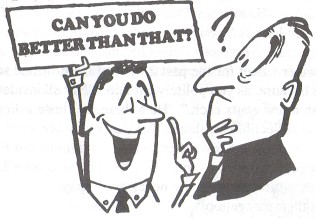
Maybe I am being a bit thin-skinned about the whole matter.
Whatever the true purpose, whether it be a fellow dealer trying to get a better
price for himself (and in turn, make a profit) or the collector with limited
funds, let's explore what a reasonable explanation for a dealer price might be.
Finding collectible insulators to offer for sale requires a bit of legwork.
People tend to call the well-known, established people in the hobby when they
are ready to sell their collections. I have found that advertising in a local
newspaper is a ready way to attract potential new customers. The cost of a
classified ad varies with the circulation of the paper. The wider the geographic
area served, the greater the cost. Of course, the buyer wants his ad to reach the most people possible hence the
more costly ad is sometimes the wisest choice.
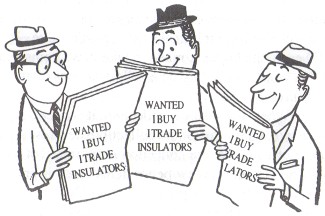
Once the ad is printed, calls
will come from people with little or no knowledge of insulators. Due to this, it
is important to follow up on almost every lead as "You never know."
More often than not, that collection you drive to see is a box of junk that has
been sitting under a leaking water faucet for the past 25 years! Uninformed
sellers are often offended because, as you politely explain, "Not all
insulators are worth more than a few cents each." Then there are those
sellers who may have some collectible insulators that they know are worth
"at least $5.00 each." Sure, maybe a few, after cleaning, might be
worth the seller's asking price, but the remaining 100 (that they also want
$1.00 each for) are usually worthless. It is not necessary to pay for a
collection and clean out their garage too!
Then the "big one" calls.
All the miles you have spent researching "accumulations" rather than
collections have become insignificant. The seller says all the right stuff..
"been collecting for 40 years... didn't know anybody wanted these
things!" "My father was a lineman for the local utility... brought
these things home in the 30's and 40's as he took them down." "Must
have over 1,000 of 'em in my garage." "Picked them up as a hobby back
in the 50' s while I was collecting bottles!" Get the idea?
Often, anyone
with something for sale will already have an asking price in mind when you
arrive. Usually this price is derived by random guess as to the value of their
merchandise. Whether or not the seller's price is "fair book value" or
just a guess, the dealer needs to calculate how much he can afford to invest in
the collection and still recoup his investment. This requires a fairly good
knowledge of prices for a large variety of insulators. Not so much a "book
price," but a current market price as to keep the resale prices fair to the
next buyer. All too often in these deals the buyer must pick up
"extras." These are the pieces that have minimal, if any, resale
value. Whether it is $.25 or $1.00 each, the buyer is made to take these items
as a term of the sale. In other words, when buying a collection, it is often an
"all or nothing" proposition.
When appraising a collection, it is
necessary to decide rather quickly what the value of the collectible items is in
order to make an offer. Let's say that the collection is appraised at $1,000.
The buyer knows he can sell the few better items at a fair price for that
amount. Does he offer the seller the total amount he knows he can recoup?
Keeping in mind the buyer expense of classified advertising, mileage, and time devoted to locating the
collection --- there is no chance that one could
pay "top dollar" and cover expenses. I will usually offer 50-75% of
the total appraisal... knowing that if I go over 75% if will be difficult to break
even. When all has been settled and agreed upon, the real work begins.
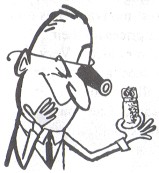
Very
often large collections have been stored by the seller in a manner that requires
major sorting and cleaning. Sorting is separating the "wheat from the
chaff," so to speak. I accomplish it by using two boxes. One goes directly
to the refuse container and the other to the sink. A general wash is always in
order to remove spider webs, dirt, grease, paint and whatever else might be
covering the insulator... then the acid bath. Most insulators come out of this
bath squeaky clean but some require further scrubbing and soaking to really
shine. As you might imagine, this process is time consuming, especially if the
collection is a large one.
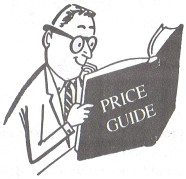
After sorting and cleaning, condition appraisals and pricing are in order. My
favorite time after buying a collection is doing just this. Keeping copies of CJs and a current price guide at hand, each and every piece is carefully
inspected for condition and any other characteristics that may influence the
sale price. For the unusual, mint-quality items, a "high book" price
is often appropriate. For the more common pieces, an average price (compared to
similar items in CJ ads) is reasonable. In general, each item is priced with two
considerations. The first is what was paid for the collection and the second is
in fairness to my fellow collectors who may purchase the item.
After sorting,
cleaning, and pricing are completed, a written inventory has to be made to allow
for accurate record keeping. This is very time consuming as each item must be
accurately described and cataloged for future sales lists or for shows. I have
found selling by mail the fastest way to reach many collectors at a reasonable
expense, however, the invoicing and packing... not forgetting frequent trips to
UPS... are a pain at best. Insulator shows are by far the more pleasurable means
to offer what has been prepared for sale. Dealing directly with the public and
other collectors is a real treat. But once again, other factors must come in to play. Often shows are a good distance from your home
and traveling has its own built in expense... motel room, food, and even though
minimal by comparison, the expense of the table at the show. By the time set up
is complete, a good amount of time and money has been spent to make one's
presence, with all those great insulators possible.
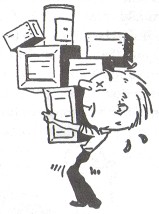
It is possible to buy and
sell a collection in this manner and maintain a small margin of profit. My
experience has been that I am usually able to keep a few choice pieces for
myself, prepare and sell a collection through the mail or at a show and still
manage to afford that next newspaper ad. My family and I would starve if we
depended on my income from buying and selling insulators as a livelihood. So you
ask, why bother? Is it that altruistic reason of bringing these treasures out
from their hiding places for the enjoyment of others? (Yes, sometimes this is a
great motivator!) Is it to rip-off unknowing sellers by paying them ridiculous
prices for their insulators and selling them at a major profit? (Not very nice.)
Very simply...it's my hobby. A hobby that allows me to meet great people, share
wonderful stories, and build memories that will last a lifetime.
So, next time
you hear and are tempted to say, "Can you do better than that?" please
try to remember what it took the dealer to bring "that" to your hand.
|
